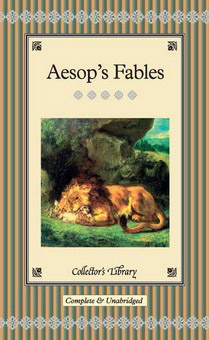Here in Lexington, fall has set in. We have the cool, crisp mornings that are perfect for curling up with a mug of coco and a good book. October always reminds me of fairy tales, fables and folklore because of Halloween. The spooky enchantment of a night characterized by the carved pumpkins, children in their costumes, and the onslaught of delicious candy and baked goods epitomize, for me, the allure of fairy tales. Last night I dug up my copy of Aesop’s Fables that I discovered at Blackwell’s bookstore in Oxford, England while I was studying abroad. At the time, I was taking a children’s literature and fantasy class and had never read through Aesop’s Fables in its entirety (my family is more of the Brothers Grimm type). Professor Hannah proclaimed that Aesop’s Fables was one of her favorite children’s books and as I sunk down in my seat avoiding eye contact I knew I needed to discover what the hullabaloo was about ASAP.
 Aesop’s Fables fulfill every characteristic of the genre. While they meet the Oxford English Dictionary’s definition as “fictitious stories relating to supernatural or extraordinary persons or incidents (…) legendary or mythological stories” many are also apologues; they have a practical or moral lesson. In fact, many common aphorisms like “do unto others as you would have done unto you” or “honesty is the best policy” are found as lessons in Aesop’s Fables. Click here to see a list of fables and their lessons. My favorite of the Aesop’s Fables is ‘The Moon and Her Mother’ because in four sentences is accomplishes two defined characters, a lesson on being too changing, and a beautiful image. It achieves what I find many flash fiction writers struggle with: defining characters, tone, theme etc. in a short amount of time while still investing and engaging the reader in the story.
Aesop’s Fables fulfill every characteristic of the genre. While they meet the Oxford English Dictionary’s definition as “fictitious stories relating to supernatural or extraordinary persons or incidents (…) legendary or mythological stories” many are also apologues; they have a practical or moral lesson. In fact, many common aphorisms like “do unto others as you would have done unto you” or “honesty is the best policy” are found as lessons in Aesop’s Fables. Click here to see a list of fables and their lessons. My favorite of the Aesop’s Fables is ‘The Moon and Her Mother’ because in four sentences is accomplishes two defined characters, a lesson on being too changing, and a beautiful image. It achieves what I find many flash fiction writers struggle with: defining characters, tone, theme etc. in a short amount of time while still investing and engaging the reader in the story.
Fables and folklore are rooted in a written and oral tradition that offers amusing insight into common lessons of life, often through the personification of animals. While in modern times the oral tradition and evolution of stories is not as present as it has been in the past, I would argue that children’s literature is the most active use of oral story telling in modern times. Children love to be read to before they go to bed. They will insist upon their favorite story, turning each page (sometimes a little bit too soon) as their parents read to them before bed. While the format of books is changing in the modern times with the e-book and new, interactive tools to try to engage children in the story, in my mind, there is no substitute for parent-children bedtime stories with a physical book that kids will draw on, drool on and tear.
Modern children’s literature does not often fall back on the flat gimmicks of moral tales that early British children’s literature was so devoted to. Nor do they always overtly rely on the sing-song rhyming that characterized many books in my childhood (thankfully). So what does the modern children’s book have that sets it apart? When I am home in Nevada and reading to my nieces before bedtime, I am captured by the beautiful illustrations and imagination that characterize books from Chronicle Books, Charlesbridge, Penguin Group, HarperCollins etc. Every time I open a newspaper or click on the TV, everyone is focusing on the change that is going on in the publishing world. Shenandoah has gone digital! But just because the form is changing, the love of literature is still out there. Authors and illustrators are amazing and their imaginations are inspiring. In this month of ghouls and ghosts, try and crack open your favorite children’s book like Aesop’s Fables and remember what it’s like to dive into a fantastical world.
This post is by: Cassie McGinty
Editorial Intern, Shenandoah
*Moral lessons facts from: http://www.aesopfables.com/aesopsel.html
*Definition of fable and apologue from: www.oed.com

